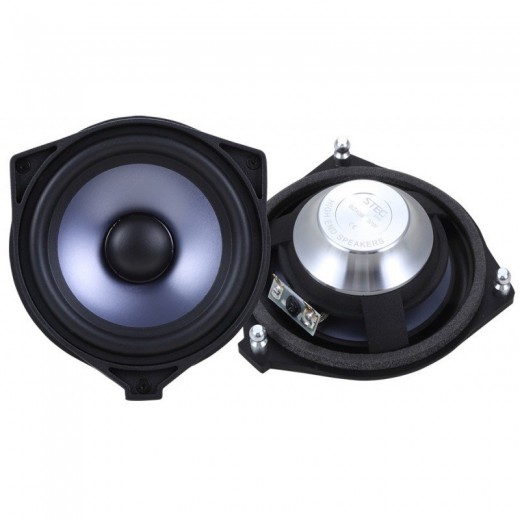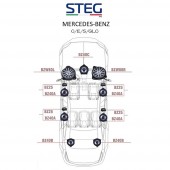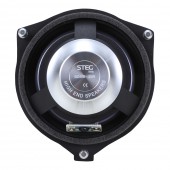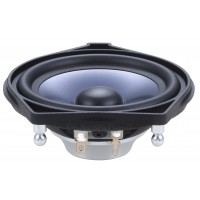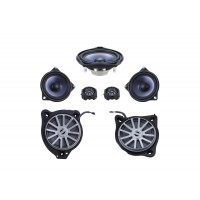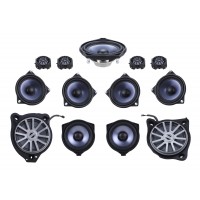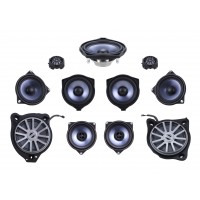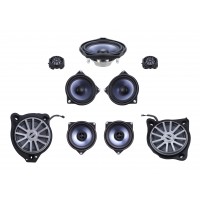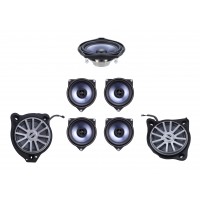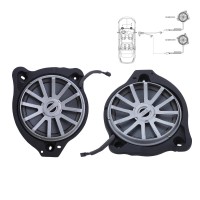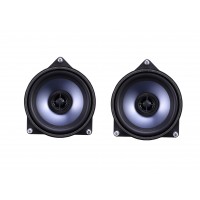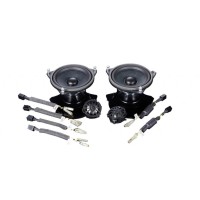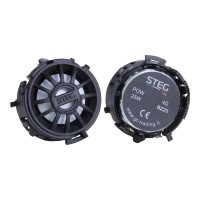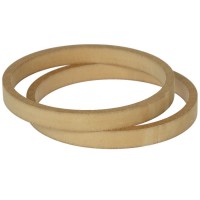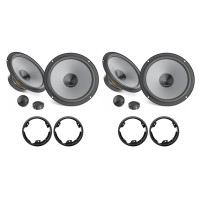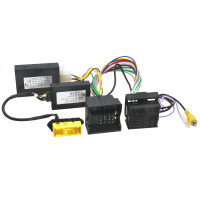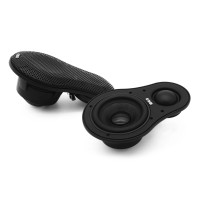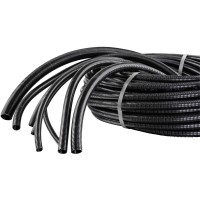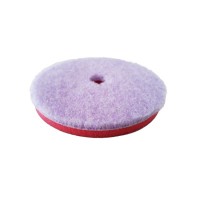STEG BZ40B center speakers
More about the product
- Use our consulting room
- You can return the goods to us within 14 days
- Try the product at our store
STEG BZ40B center speakers for Mercedes-Benz
Mercedes-Benz as a brand is certainly synonymous with quality and German precision. As for the audio systems, however, like in any other car, there is not much emphasis on it. If you don't have an S-Class with the additional Burmester 3D audio equipment for 169 thousand crowns, you will not fully enjoy the sound in the Mercedes. However, the STEG brand offers hope for improvement to owners of C, E, S, GLC, GLE or GLS cars. It is the only one in the world with a comprehensive upgrade program! As can be seen from the philosophy of the STEG brand, all products are based on several years of testing and selection of the best materials. It is no different with these loudspeakers for Mercedes-Benz cars, in which all these many years of development are reflected.
How STEG speakers for Mercedes-Benz are installed
You don't have to modify, cut or otherwise adapt anything in the car, connect amplifiers to the original system in any complicated way or disturb the electronics. Entire sets of speakers are precisely adapted to the replacement of original speakers, using a plug and play system. It couldn't be simpler! The speakers are more sensitive, have higher performance and, thanks to high-quality materials, also a completely different sound. Therefore, there is a huge difference even when connected to the original system. The intention of the Italian developers was to bring you the experience of a live concert in your car, and they succeeded 100% with these speakers!
The speaker set includes:
- 2 x 100mm center speaker.
- Complete assembly material for installation.
| Catalog number | BZ40B |
| Brand | Steg |
| Links | Official web presentation |
| Speaker typeCoaxial speakers: Coaxial speakers are characterized by a so-called all-in-one design. The tweeter and mid-bass speaker are in one basket. The advantage is simpler assembly, but thanks to the connection or proximity of the bands in one speaker, the sound quality will usually be reduced. As a rule, in the middle of the mid-bass speaker, there is a tweeter whose voice coil works in the second air gap of the common magnetic circuit. The three-way coaxial speaker consists of a mid-bass speaker, a center speaker and a separate tweeter in the front on a special beam. Component Speakers: Component speakers are characterized by a division into individual frequency bands, treble + mid-bass + or. bass band. The individual speakers can be placed completely separately, which results in a better sound and acoustic performance. In the vast majority of cases of component speakers, an external crossover is also supplied, which divides the treble, middle / mid-bass, and into the three-band the bass band or allows setting the decibel level of the tweeter (e.g. +2 dB, 0 dB, -2 dB), steepness (e.g. 6dB/Oct. 12dB/Oct.) or active or bi-amp connection. | Central |
| RMS powerRMS speaker power is the constant power of the entire system, not just one speaker or one side. This is also the performance of continuous use of the speakers. If the RMS power is exceeded for a long time, the speakers may be irreversibly damaged! | 50 W |
| Sensitivity (SPL 1W/1m)Sensitivity, sensitivity or efficiency of the speaker. Speaker sensitivity is given in decibels (dB) and simply put, the higher the value, the lower the demands on the amplifier's power. This is a defacto rating of how a speaker converts watts to sound. Sensitivity ratings are in noise level measured at 1 meter from the speaker using 1 W (watt of power) or using 2.83 volts at the source at 1 meter. A higher decibel level means the speaker is louder with less power. For every 3 dB increase in sensitivity, the speaker requires half the power to reproduce the same volume. For example, if an 88 dB speaker needs 100 Watts to produce a certain volume, then a speaker with a sensitivity of 91 dB needs only 50 Watts to reach the same volume. | 88 dB |
| ImpedanceImpedance - measurement of electrical resistance. When buying speakers, it is important to make sure that the impedance matches the amplifier or car stereo you are using. Example: A 2 Ohm speaker cannot be connected to an amplifier that is only stable up to 4 Ohms! A 4 Ohm speaker can easily be used with an amplifier that is stable up to 2 Ohms. The most common speaker impedance today is 3 - 4 Ohm. | 4 Ω |
| Frequency rangeThe ability of the speakers to play a signal from the lowest frequency to the highest, or the speaker's ability to faithfully reproduce sound in a specific frequency band. Professionally: In the frequency range from 40 to 16,000 Hz, the vast majority of fundamental and overtones (harmonics) of all musical instruments are found. We are interested in the course of the radiated sound pressure in this range of frequencies when the loudspeaker system is supplied with constant power. We call this course the frequency characteristic, which tells us the level of radiated sound pressure in decibels (dB) depending on the frequency. The frequency characteristic of a speaker or speaker system can be expressed most succinctly with a graph. Mostly, however, the frequency characteristic is indicated by indicating the maximum tolerance of the sound pressure in the given frequency range, e.g. 50 to 15,000 Hz -+ 6 dB. Since the frequency characteristics of loudspeakers and systems in general are quite uneven, some manufacturers do not even specify this maximum tolerance of sound pressure in decibels in their catalogs for reasons of prestige. Data impoverished in this way is unfortunately worthless. What is valid is that the manufacturer offers a speaker system with a frequency range of 30 to 20,000 Hz, if he is worried about stating the maximum unevenness of the sound pressure in this range, because he can have a tolerance of, for example, +- 20 dB. The unevenness or undulation of the frequency curve in good speaker systems for high-quality music performance should not exceed +-3 dB in the 80 to 12,000 Hz band and +-6 dB in the 40 to 16,000 Hz band. Greater unevenness already depletes or emphasizes certain tonal areas, which can cause audible or even disturbing distortion. The proportion between fundamental tones and higher harmonics also changes, thereby changing the color of the sound, and individual musical instruments as well as the entire musical image sound unnatural. | 90 - 15000 Hz |
| The diameter of the mid-bass speakerWe state the diameter of the speaker as the diameter of the entire speaker, not including the mounts, when smaller speakers (87, 100, 130 mm) have extra mounts. Some speakers are oval and there the dimension is given in inches, always the shortest side to the longest side. One inch is approx. 2.5 cm. | 100 mm |
| Installation depth of the mid-bass speakerThe installation depth of the speaker is measured from the bottom edge of the magnet to the bottom edge of the tin, plastic or cast speaker basket, or speaker bearing surfaces. | 42 mm |
| Center speaker diaphragm materialDiaphragm material that was used in the manufacture of the center speakers. | Aluminium |
| Other | For Mercedes C, E, S and GLC cars. (in cars C and E, these speakers are only in versions with Burmester audio system) |
| Price forIf the price is for a pair, the package always includes 2 pieces of everything, e.g. 2x mid-bass, 2x tweeter and 2x crossover. | Few |
Product comments
Evaluation
- Car speakers Speakers by car brand Speakers for Mercedes-Benz Speakers for Mercedes-Benz GLC Class (W253)
- Car speakers Speakers by car brand Speakers for Mercedes-Benz Speakers for Mercedes-Benz C-Class (W205)
- Car speakers Speakers by car brand Speakers for Mercedes-Benz Speakers for Mercedes-Benz E-Class (W213)
- Car speakers Speakers by car brand Speakers for Mercedes-Benz Speakers for Mercedes-Benz S-Class (W222)
- Car speakers 100 mm car speakers Center speakers 100 mm
- Promotional goods and sales Car speakers on sale
- STEG speakers, amplifiers and subwoofers
